Want to try authentic Czech food? Don't miss "kolache" by any means! Kolache (plural, in Czech kolace) are a round sweet pastry with various fillings. The kolache came to the USA with Czechs who moved there to start a new life at the turn of the 18th and 19th centuries. Since then, kolache have been a great success, and no wonder they taste fantastic!
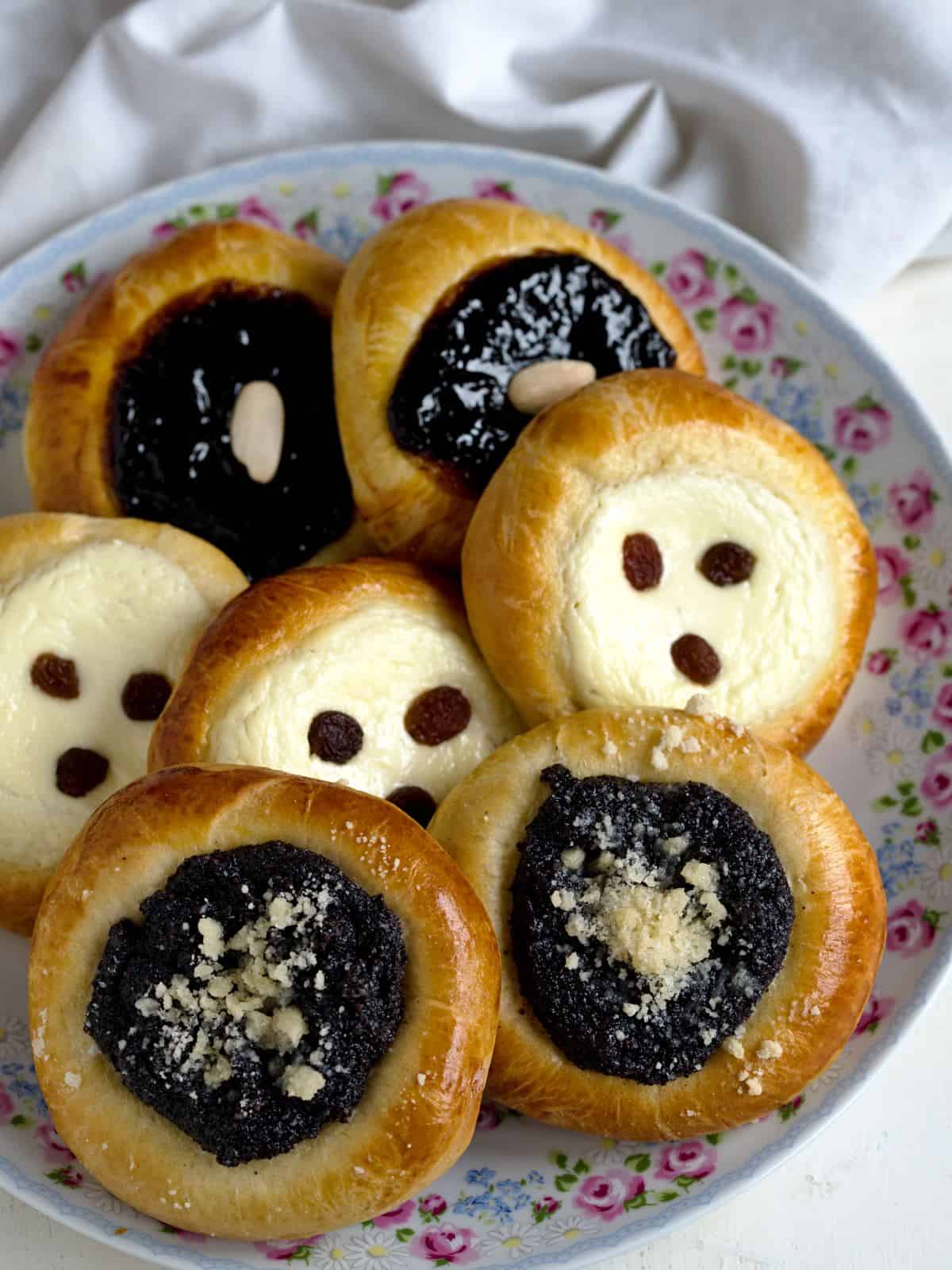
➜ What Is Kolache?
Kolache are a sweet Czech pastry made of yeast dough. Kolache are flat, generously filled in the middle with fruit, poppy seed, or cream cheese filling. They always have a round shape and are about 3–4 inches (8–10 cm) in diameter.
Before baking, the sides of the pastry are brushed with a beaten egg. Most of them are sprinkled with streusel topping (posypka) on their surface.
Original and authentic Czech kolache are round, not square. They are served nicely filled, with just the right amount of streusel.
MY TIP: Try Czech buchty brioche, sweet-filled buns (they are fantastic!)
➜ How to Pronounce Kolache
I recorded a short audio clip to hear the Czech pronunciation of the word kolache (koláče). I am a native Czech, so you get the pronunciation firsthand!
The first two words in the audio clip mean "koláč" (1 piece of kolache). The last two words mean "koláče" (2 and more pieces of kolache).
➜ Kolache or Kolaches?
Wondering what the plural of kolache is? Let me explain.
One piece is called a "koláč" (a kolach) in Czech. Two or more pieces are called "koláče" (kolache). So, the word kolache is plural in itself!
However, in the US, the letter s is often added to the end of the word kolache to form the word "kolaches". This means that the word kolaches is actually a double plural.
You may also come across various other names from a corruption of the word kolache; most often, they are koulache or colaches.
➜ Ingredients
Dough for kolache:
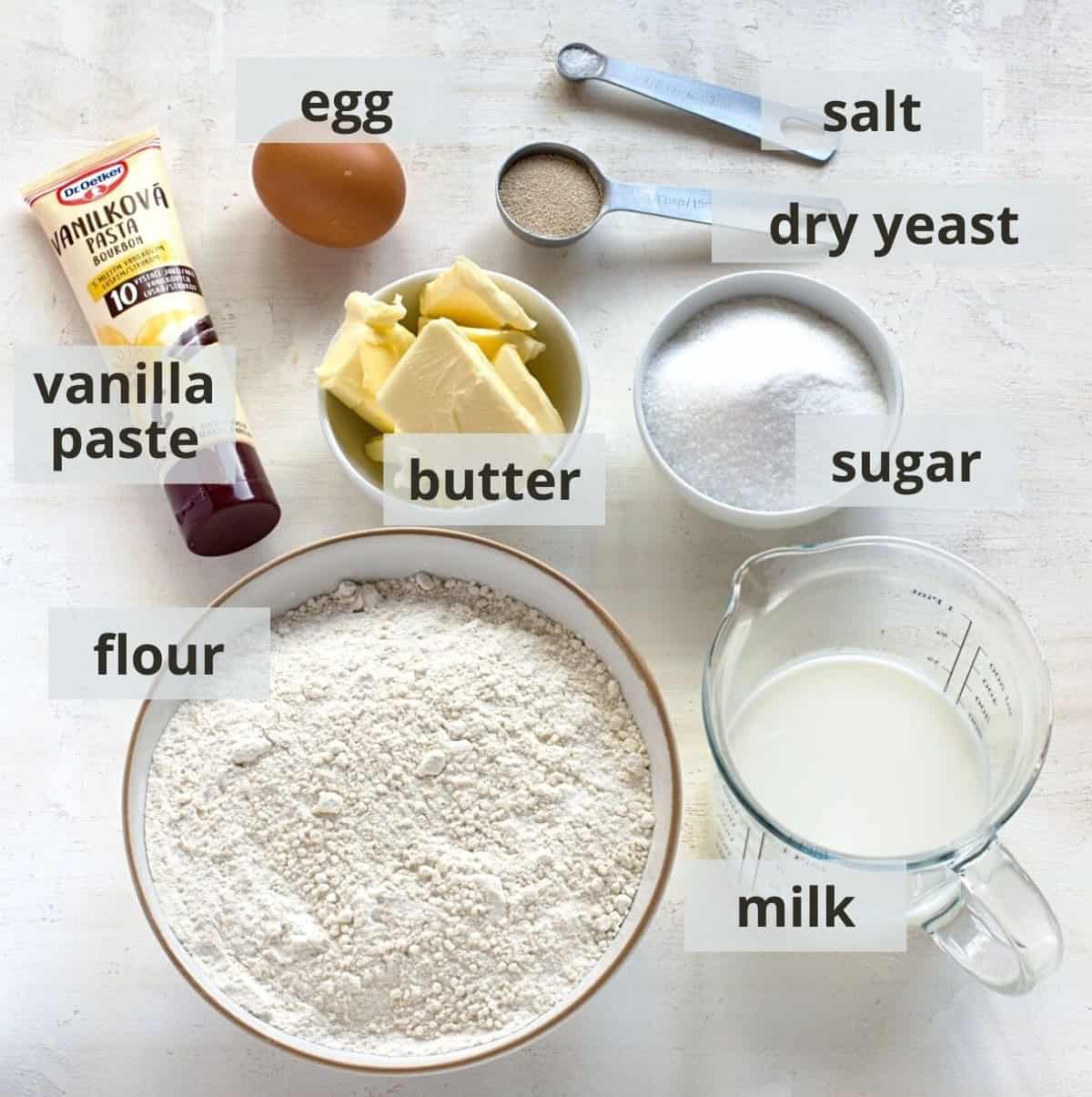
To make kolache dough, you’ll need:
- All-purpose flour; any plain wheat flour should work fine (Czech equivalent: hladká mouka). Read more about types of Czech wheat flour.
- Milk; lukewarm to support activating of the yeast. This means it shouldn't be too hot or too cold. If the milk were too hot, it would kill the yeast, which would not rise.
- Unsalted butter; melted or at least softened, not hot. I always put the butter in a bowl and microwave it for 30 seconds (microwave on medium power).
- Egg; whole
- Coarse sugar
- Vanilla paste; or vanilla sugar. It gives a pleasant aroma to the dough. I have Dr. Oetker vanilla paste at home. I looked it up in the US, and it's available on Amazon.com. If you don't have any vanilla paste, you can omit it.
- Active dry yeast; Czechs usually use fresh yeast. I used dry yeast in this recipe for simplicity, which works perfectly!
- Salt; just a little for a pleasant taste contrast.
You'll need one egg for an egg wash. Brush it on the sides of the cakes before baking for a beautiful golden glossy color.
✅ You’ll find the exact amount of ingredients below in the recipe card, which you can also print out.
Fillings for kolache:
Next, you need kolache fillings. In the Czech Republic, the most commonly used are poppy seed filling, cream cheese filling, or prune jam filling. Looking for something interesting? Try this sweet cabbage filling according to the traditional Czech recipe!
In the USA, fruit fillings such as apricot or peach are very popular. Take any thick fruit filling that works well for you when baking.
➜ Instructions with Photos
STEP 1: In a small saucepan, heat the milk until lukewarm. Put your little finger in it. If the milk is nicely warm yet not too hot, it's ready!
Pour the dry yeast and a teaspoon of sugar into the milk. The sugar will encourage the yeast to activate. Stir everything with a spoon and leave it in a warm place (photo 1) for about 10-15 minutes until foam forms on the surface (photo 2).
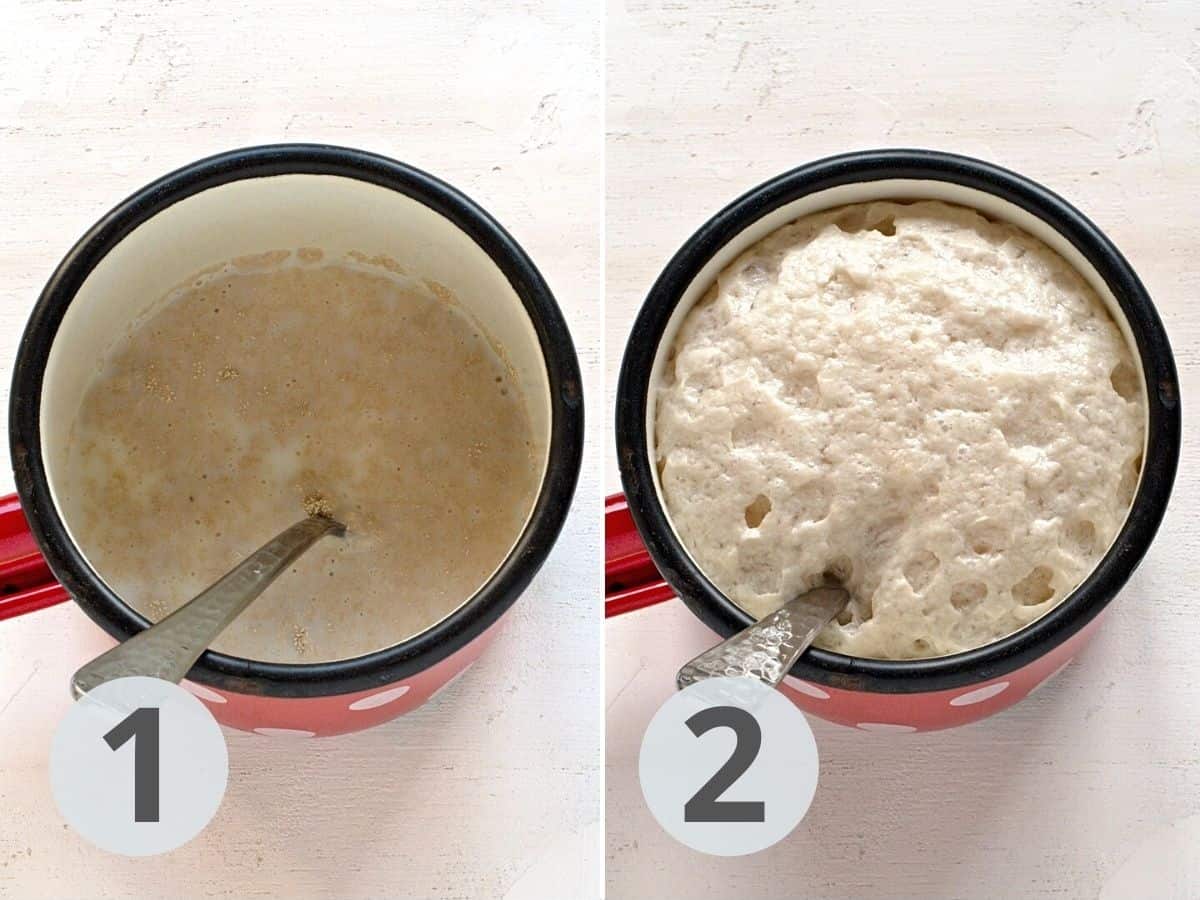
STEP 2: Meanwhile, melt the butter, which should be semi-liquid but not hot. Around 30 seconds in the microwave is ideal.
STEP 3: Add the flour, sugar, and salt into a mixing bowl. Add an egg, vanilla, melted butter, and activated yeast with milk.
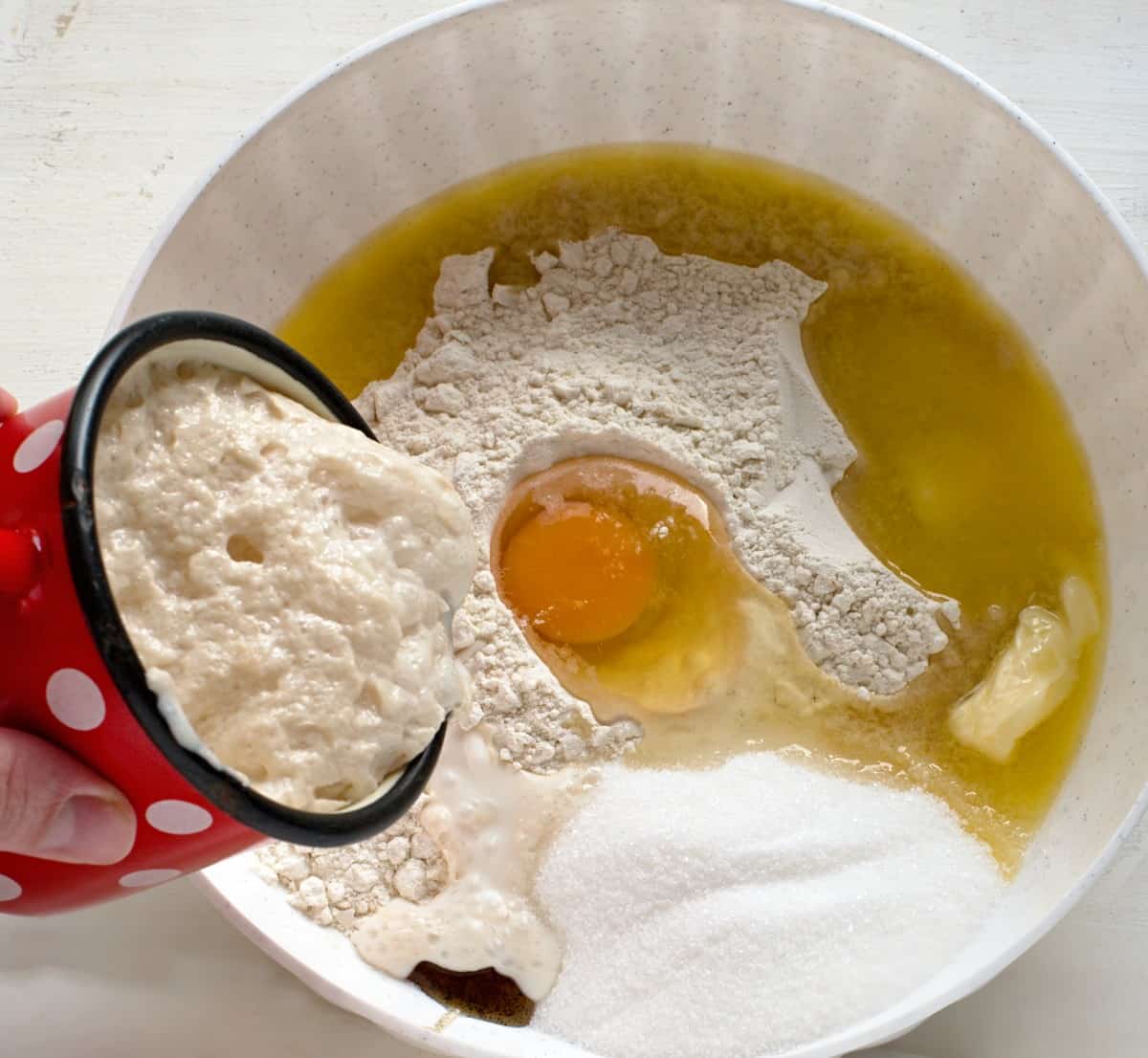
STEP 4: Begin with the dough. Roughly combine all the ingredients in a bowl with a fork (photo 1). Pour the mixture out onto a floured work surface and use your hands to work it into a smooth elastic dough (photo 2).
If the dough is too sticky, dust it with a tablespoon of flour and continue kneading. Repeat until the dough is no longer sticky.
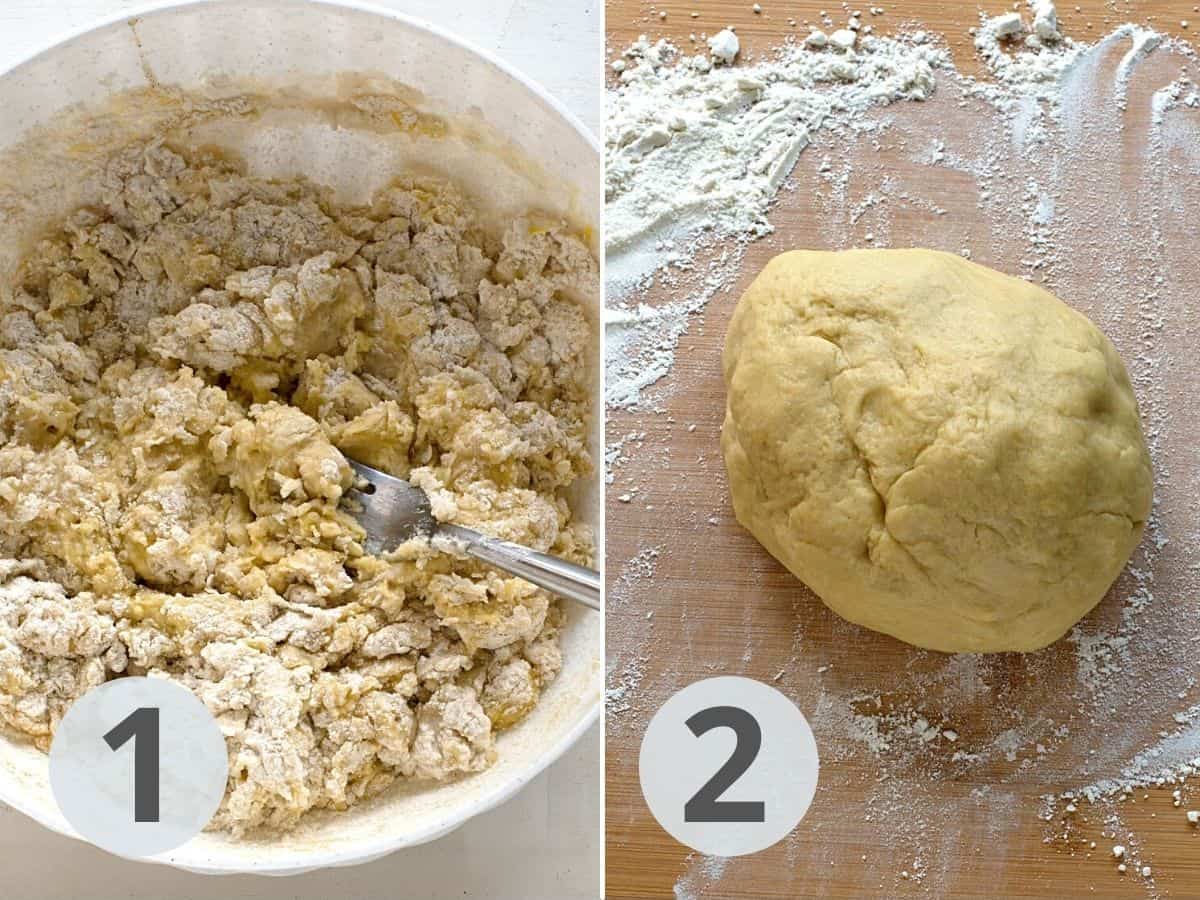
If you have a stand mixer you're used to making yeast dough in, feel free to use it. It'll save you work!
STEP 5: Put the dough back into the bowl (photo 1) and let it rise in a warm place for 40 minutes (photo 2).
MY TIP: I let the dough rise in the oven, on the bottom of which I placed a pot with hot, lightly steaming water. Close the oven door. The warm and humid environment does wonders for the dough, it always rises well.
⤍ Learn how to make dough rise in the oven.
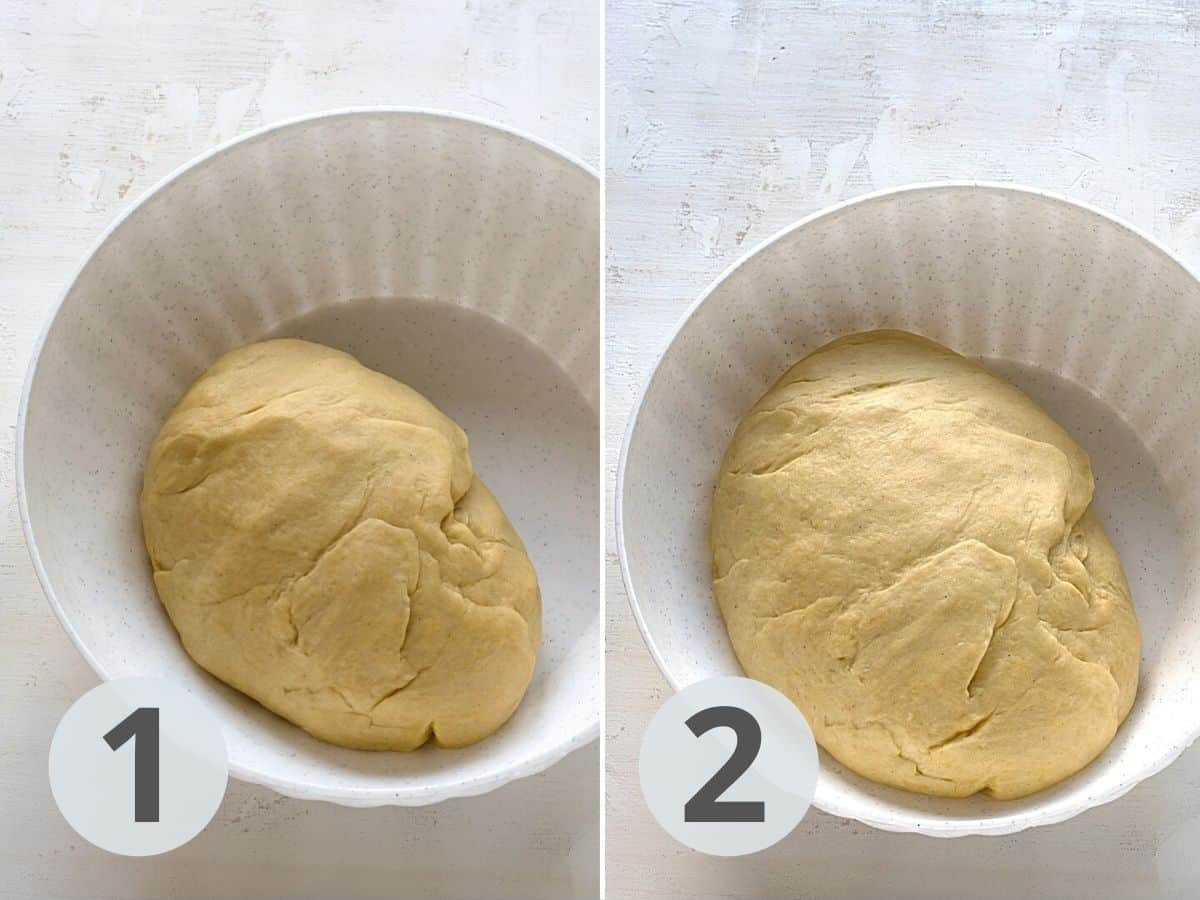
STEP 6: Transfer the dough to a work surface and divide it into equal parts. If you have a kitchen scale and want kolache the same size, weigh each piece on the scale. The weight of a piece of dough for one pie is around 1 and 1/2 oz (45 g).
Shape each piece of dough into a ball. Place it on a baking sheet lined with wax paper. Leave enough space between the balls so that the cakes don't touch and bake into a square later. The classic Czech kolach is round!
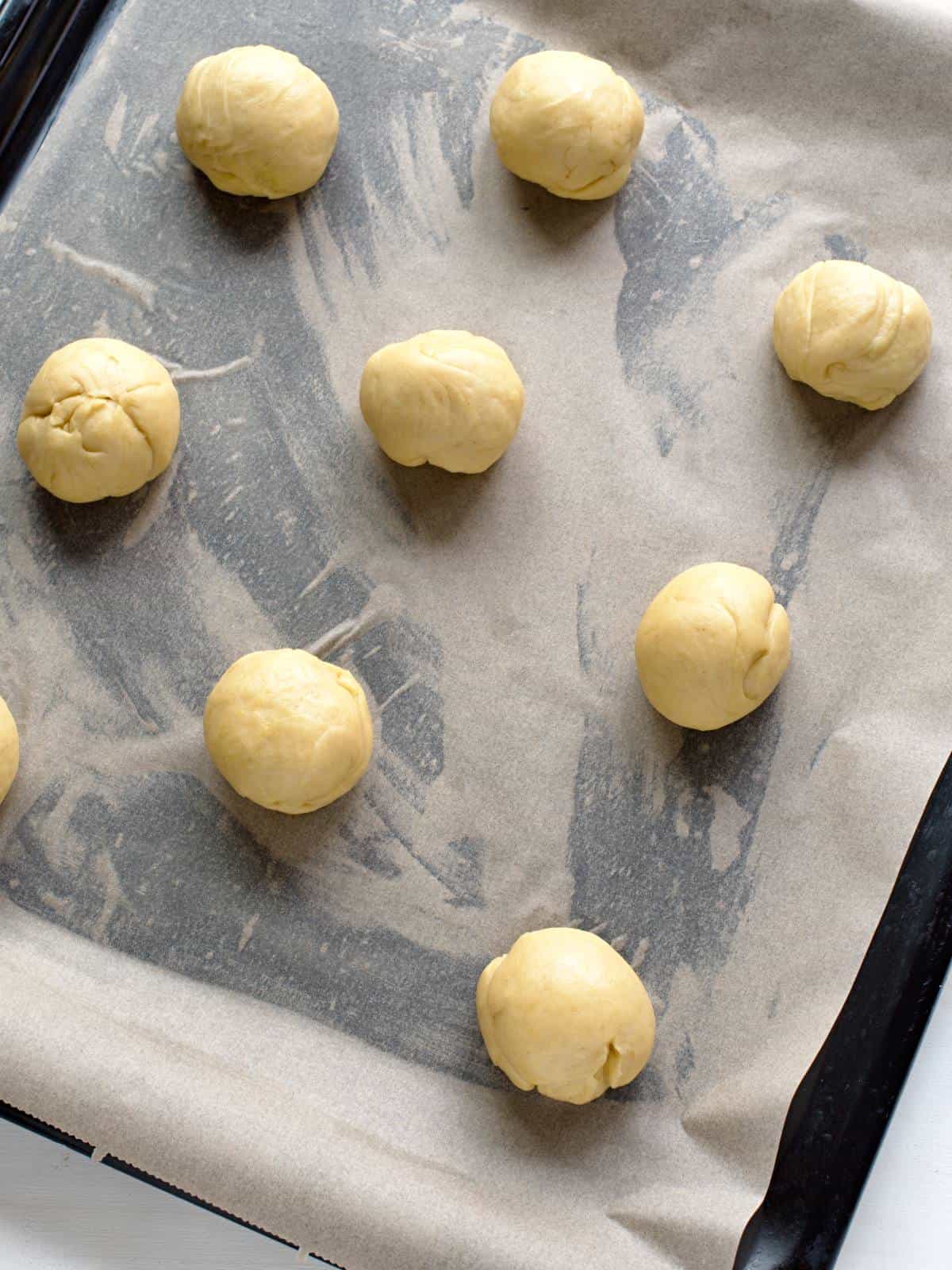
MY TIP: I used a baking sheet about 17x14 inches (43x36 cm). I could fit nine pies in it.
STEP 7: Let the dough balls rise in a warm place for another 40 minutes. Cover the dough with a clean tea towel if you leave the dough to rise on the kitchen counter. I put the baking sheet back in the oven with a pot of warm water.
STEP 8: Time to shape kolache! We need to create a beautiful round kolach and create a depression in the center for the filling placement.
Take a round-bottomed vessel about 3 inches in diameter, such as glass. I used a 1/2 measuring cup.
Wrap the bottom with a clean dish towel so that there are no creases.
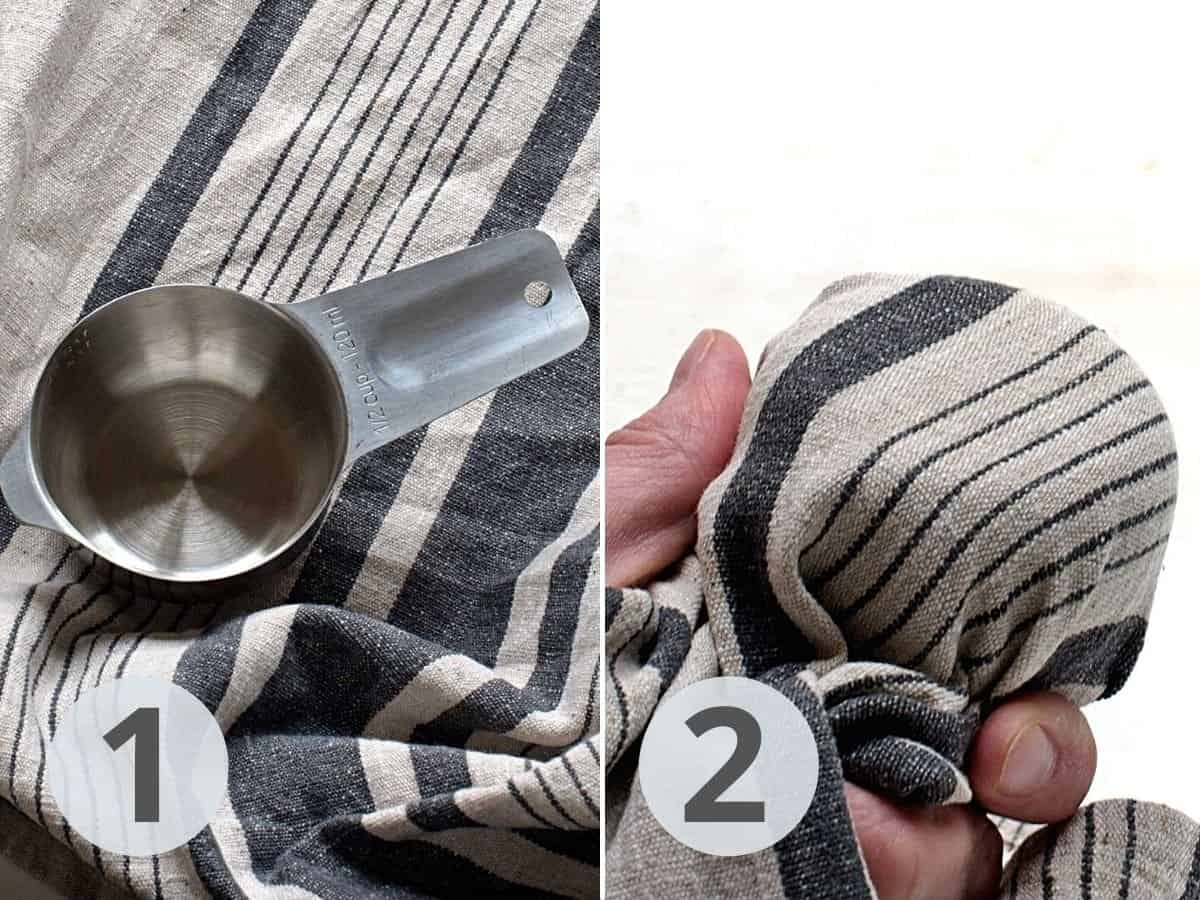
Press the wrapped vessel evenly into the dough with light pressure from above. The kolach is stretched out wide and round, and an indentation is made in the middle for the filling.

MY TIP: Wrapping the container with a dish towel prevents the dough from sticking to the container.
STEP 9: In a shallow bowl, beat an egg using a fork and create an egg wash. Brush it over the edges of the kolache pastries.
After baking, the beaten egg creates a golden and shiny surface on the kolache edges. If you want this effect to be less pronounced, add a tablespoon or two of water to the beaten egg.
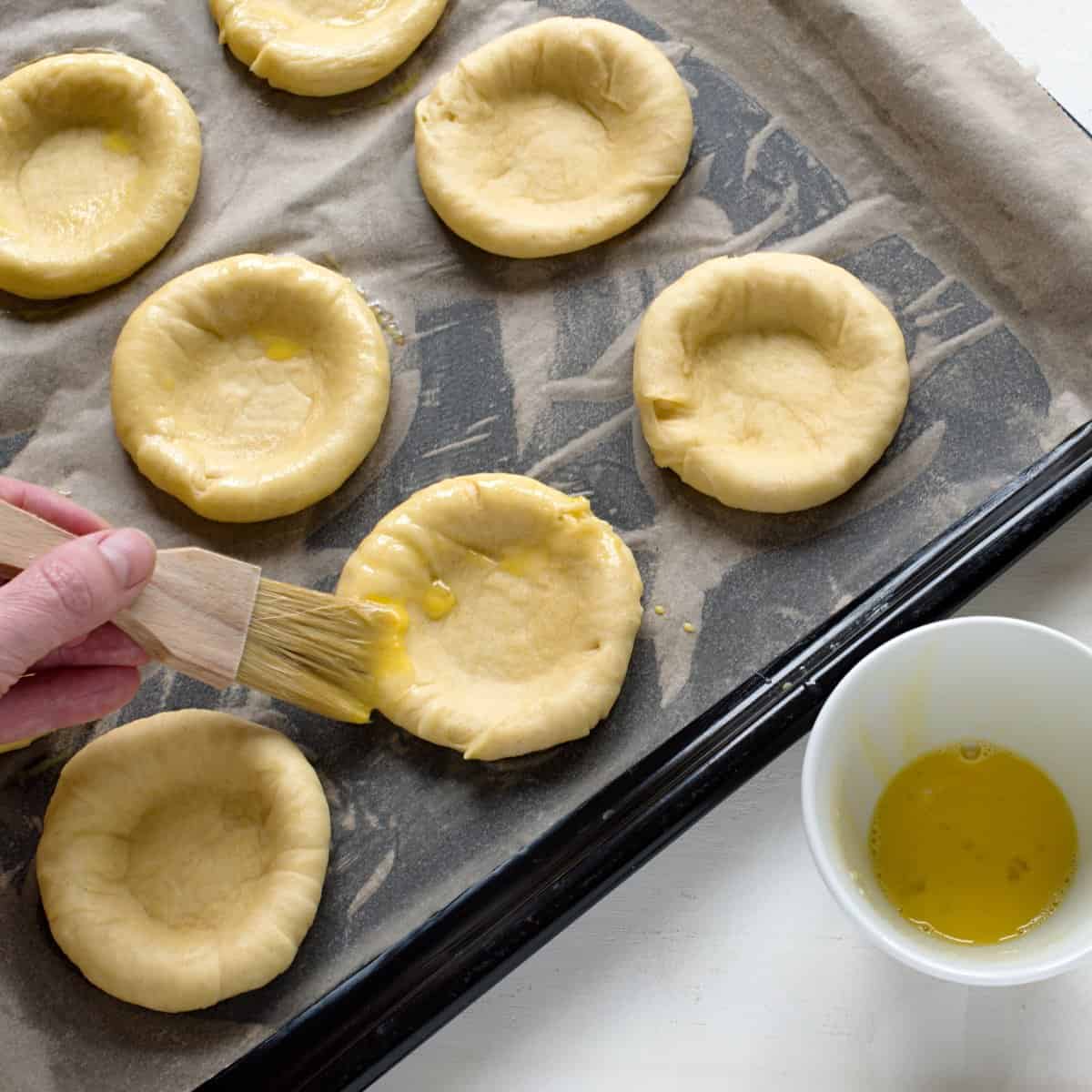
STEP 10: Now, place the filling in the middle of each kolach. Just about 1 to 1.1/2 tablespoons per kolach are enough. If you like, sprinkle the cakes with streusel topping.
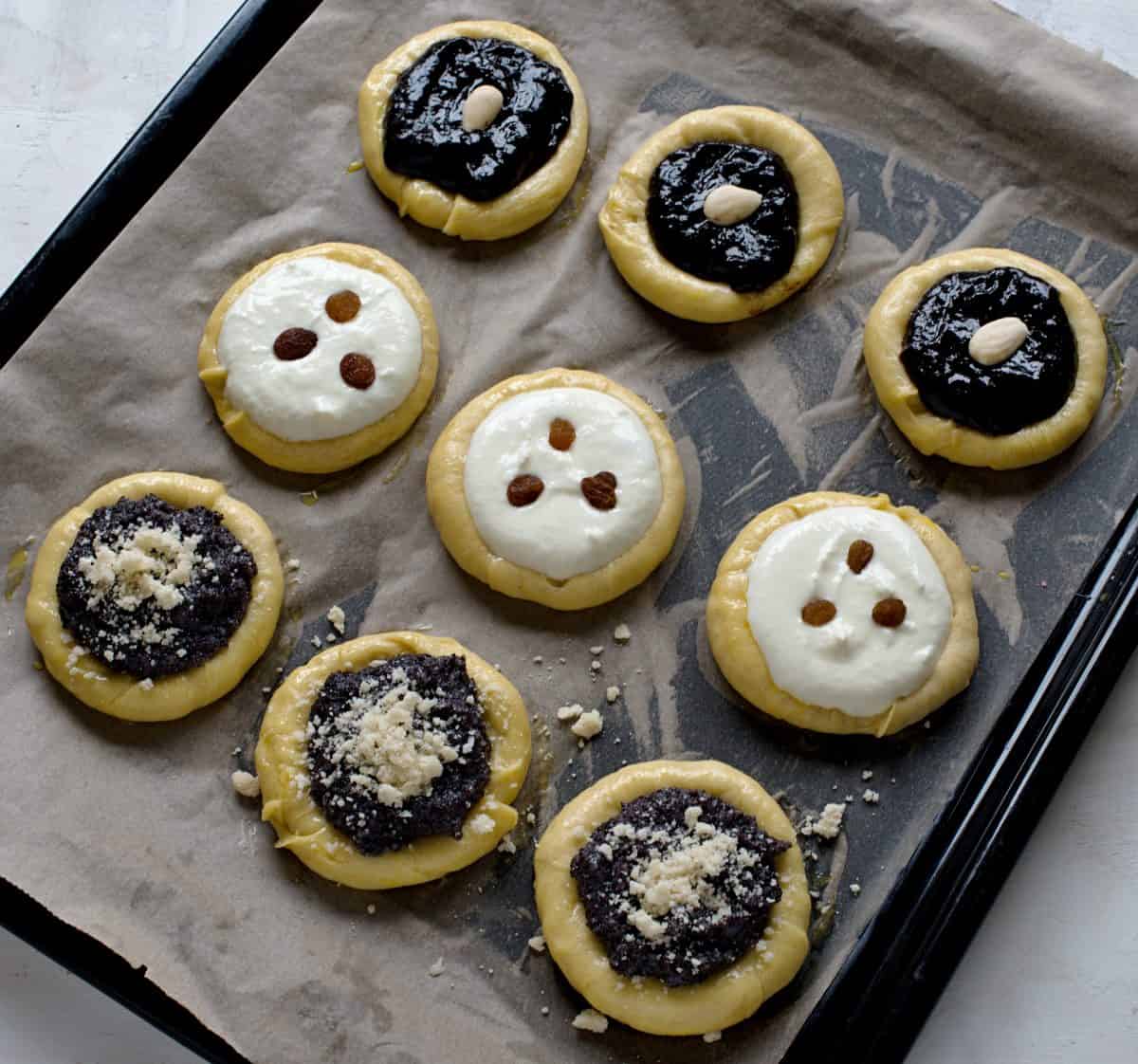
STEP 11: Let's bake kolache! Preheat the oven to 350 °F (177 °C). Place the sheet with kolache in the oven and bake for 15-20 minutes until the edges are golden brown.
➜ Decorating on the Surface
The surface of old Czech country kolache was usually decorated. Czech grannies (babi or babička is the Czech word for grandmother) adorned the kolache with contrasting elements or combined different fillings to create impressive decor.
Kolache decorating varies from region to region in the Czech Republic. Chodske kolace (Chodsko is a historical area in western Bohemia) is probably the most famous; they have unique patterns.
On the kolaches in this recipe, I show an example of typical decorating, which is simple and everyone can do.
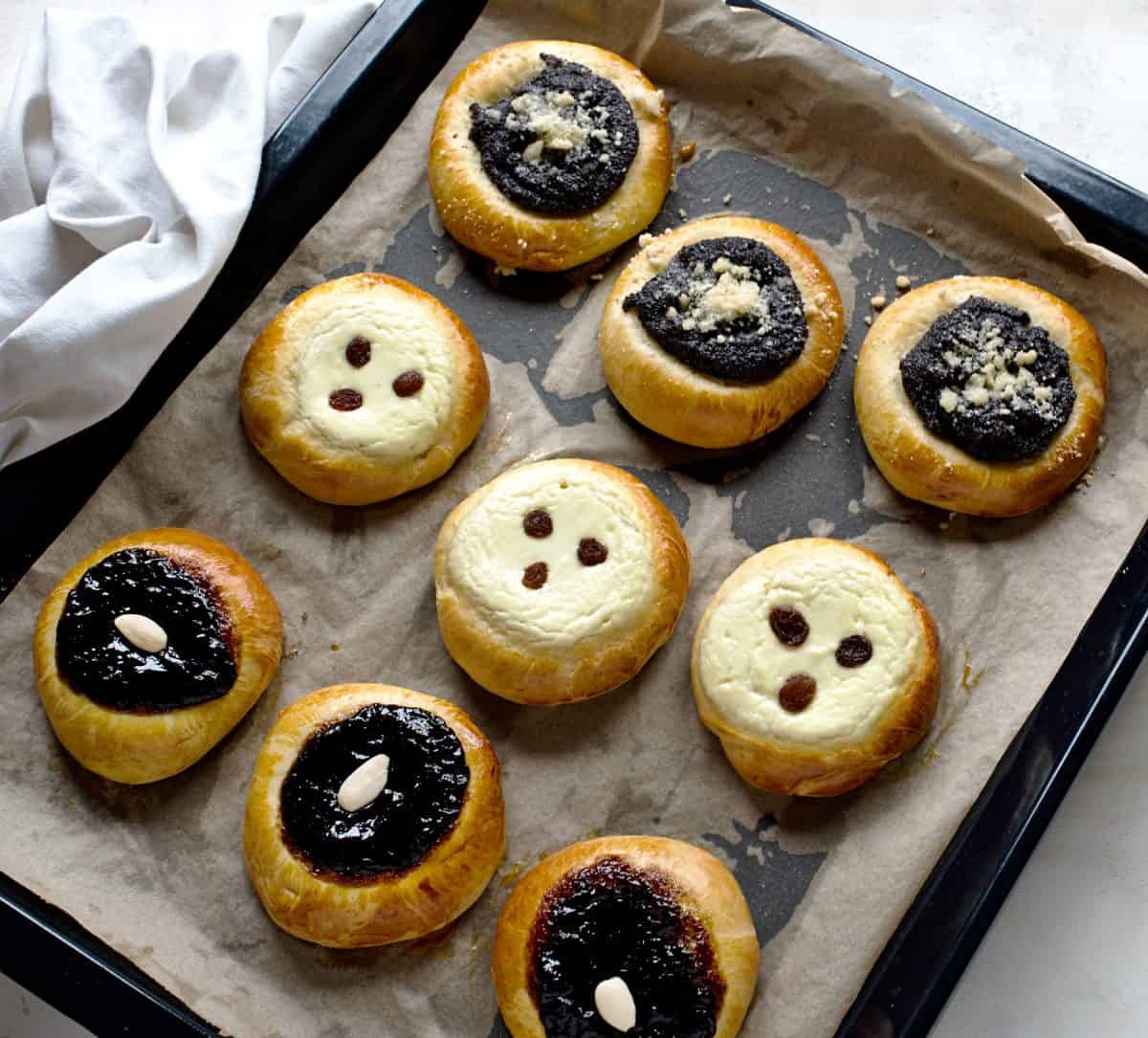
Cream cheese filling: Place three raisins in the middle of the cake in the shape of a small flower.
Prune jam filling: Place one blanched almond in the middle. Or three halved blanched almonds, again in the shape of a flower.
Poppyseed filling: Sprinkle the surface of a kolach with a small amount of streusel topping (drobenka, posypka). Avoid too much streusel; the filling must peek out under the topping.
➜ Serving
There is no secret, freshly-baked kolache taste the best! Enjoy them still lukewarm with your cup of good coffee or tea.
MY TIP: Kolache are also great for a potluck if you want to introduce your friends to a typical dish from Czech cuisine.
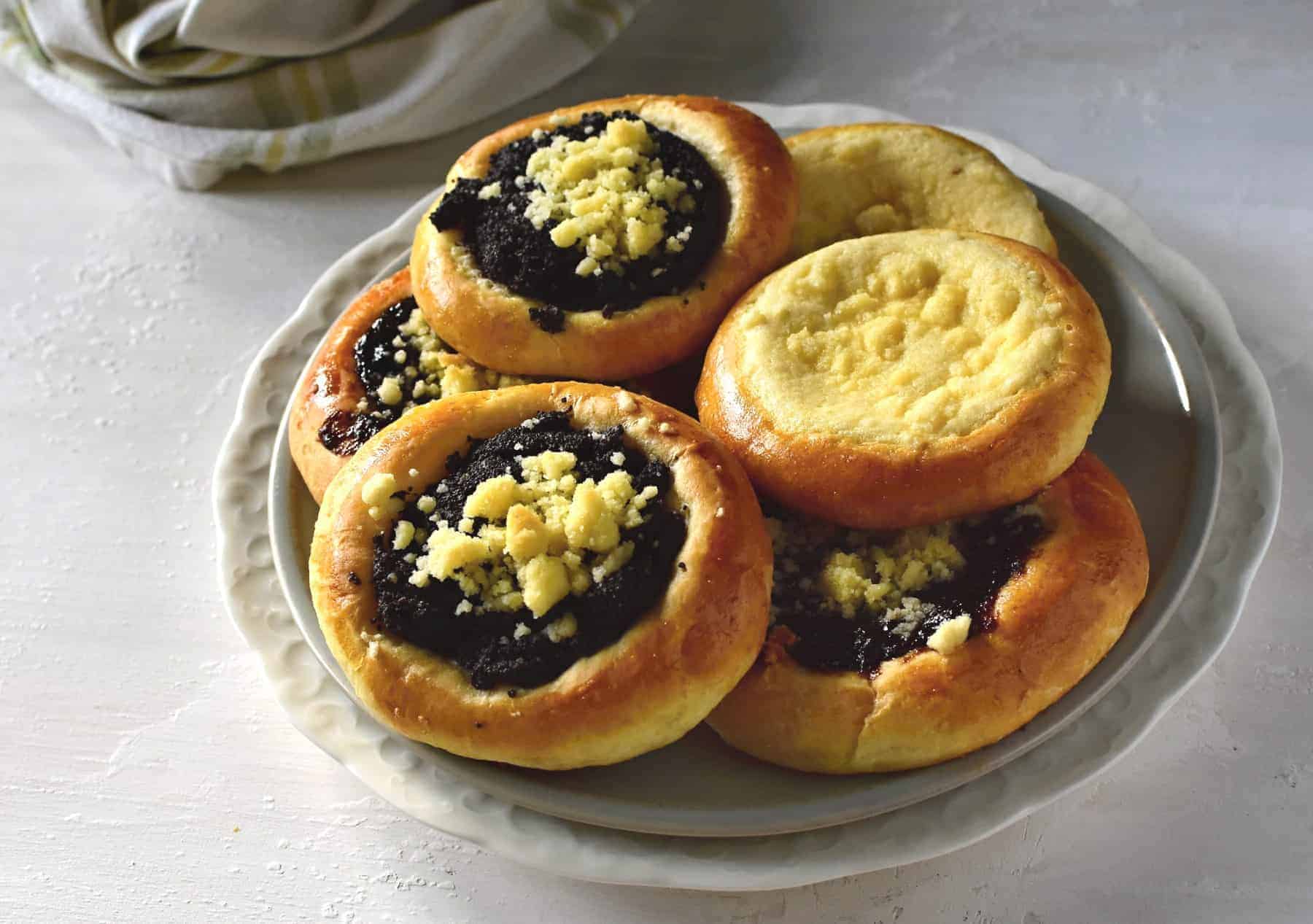
➜ Storage
At room temperature: Kolache taste best the same day you bake it. Stored in an airtight container, they will keep at room temperature for around three days.
Store the kolache with fresh cheese filling in a fridge or another cool place.
How to freeze kolache: Do you have any kolache left? There's nothing better than freezing them! Put kolache in a freezer as soon as possible, preferably the same day you bake them.
Place kolache in a plastic bag and put them in a freezer. After about 20 minutes, shake the kolache and separate them from each other. This will prevent the pieces from sticking together.
The kolache will keep in the freezer for three to five months.
Reheating kolache: Take out the number of kolaches you intend to eat. Let them thaw slowly on the kitchen counter at room temperature. Cover them with foil to keep kolache from drying out. They will thaw entirely in about two hours.
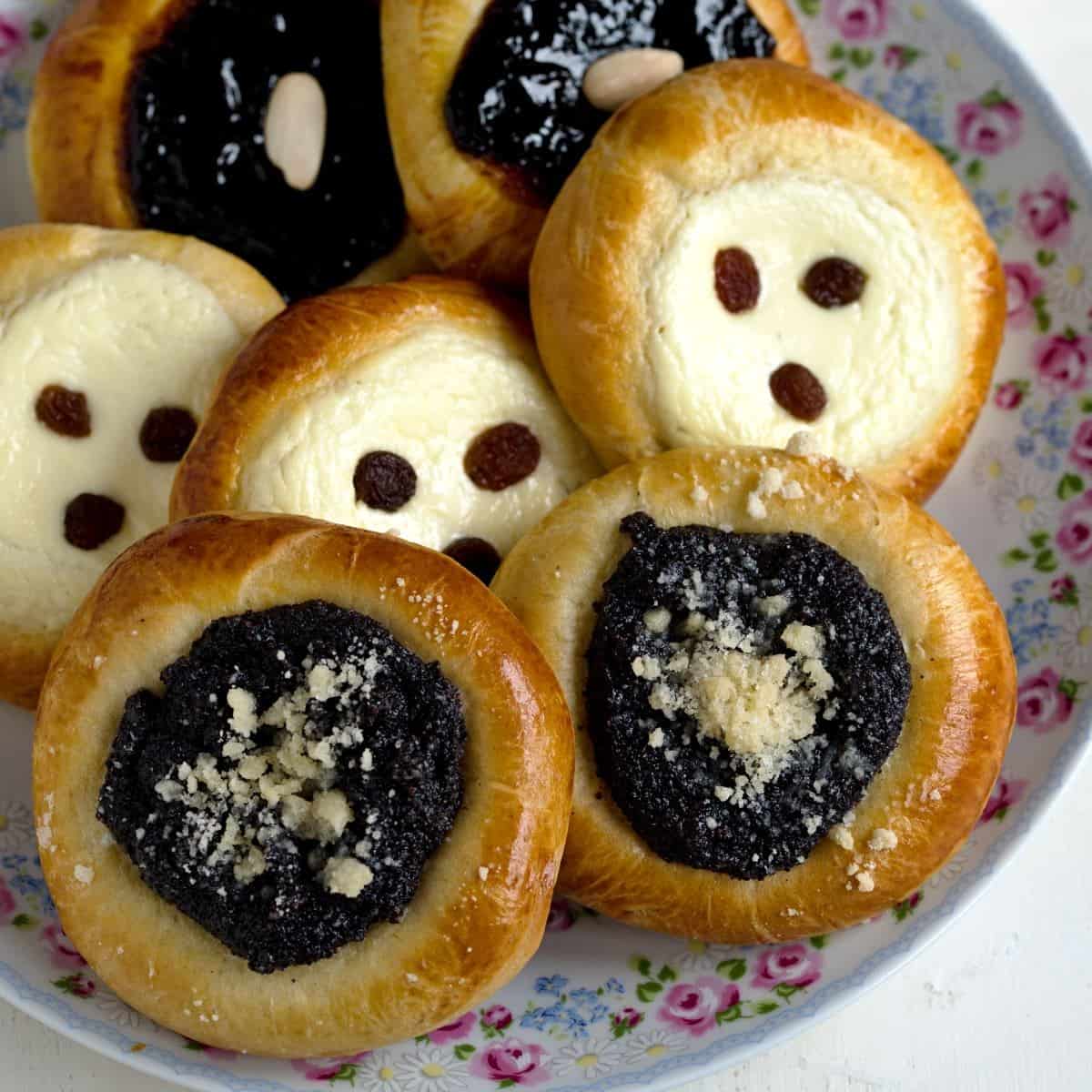
➜ Useful Tips
- Kolache dough needs to rise twice. First as dough itself, then as dough formed into balls (see the recipe). If you cheat the rising process, kolache won't be flat, the middle will lift, and the filling will ooze out.
- You may have come across the American version of kolache, which is savory (e.g., pig in the blanket). I assure you that classic Czech kolache are always sweet. Salty kolaches are an American invention, which has nothing to do with the real Czech ones.
- In the USA you can buy kolaches in local Czech bakeries. Most of them can be found in Texas, where a sizeable Czech community gathers. Hruska's kolaches are well-known and popular; their company resides in Utah. Another famous Czech bakery where kolaches are available is Vesecky’s Bakery in Illinois.
More Czech pastries:
- Houska Christmas bread, currently known as vánočka
- Bublanina, a fruit sheet cake
- Apple strudel
- Poppy seed kolache
- Prague kolach cake
Tried this recipe?
Leave a review down in the comments! ⭐⭐⭐⭐⭐
Follow me on Facebook and Pinterest. Subscribe to my newsletter. Send me any question about Czech cuisine to my e-mail. I love hearing your feedback!
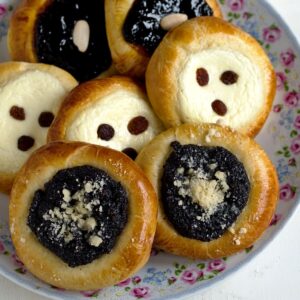
Czech Kolache Recipe
Ingredients
- 3 and ½ cups all-purpose flour (450 g)
- ¾ cup milk (180 ml) lukewarm, not hot
- 2 and ½ teaspoons active dry yeast
- ⅔ stick unsalted butter (75 g) melted, not hot
- ⅓ cup coarse sugar (70 g)
- 1 egg
- 1 teaspoon vanilla paste optional
- pinch of salt
For an egg wash:
- 1 egg beaten with a fork
Fillings for kolache:
- to your liking
Instructions
- In a small saucepan, heat the milk until lukewarm. Pour the dry yeast and a teaspoon of sugar into the milk. The sugar will encourage the yeast to activate. Stir everything with a spoon and leave it in a warm place for about 10-15 minutes until foam forms on the surface.
- Meanwhile, melt the butter, which should be semi-liquid but not hot. Around 30 seconds in a microwave are ideal.
- Add the flour, sugar, salt into a mixing bowl. Add an egg, vanilla, melted butter, and activated yeast with milk.
- Begin with the dough. Roughly combine all ingredients in a bowl with a fork. Turn the mixture out onto a floured work surface and use your hands to work it into a smooth elastic dough. If the dough is too sticky, dust it with a tablespoon of flour and continue kneading. Repeat until the dough is no longer sticky.
- Put the dough back into the bowl, cover with a clean kitchen towel and let it rise in a warm place for 40 minutes.
- Transfer the dough to a work surface and divide it into equal parts. If you have a kitchen scale and want kolache the same size, weigh each piece on the scale. The weight of a piece of dough for one pie is around 1 and ½ oz (45 g).
- Shape each piece of dough into a ball. Place it on a baking sheet lined with wax paper. Leave enough space between the balls so that the cakes don't touch and bake into a square later. The classic Czech kolach is round!
- Let the dough balls rise in a warm place for another 40 minutes. Cover the dough with a clean tea towel if you leave the dough to rise on the kitchen counter.
- Time to shape kolache! We need to create a beautiful round kolach and create a depression in the center for the filling placement. Take a round-bottomed vessel about 3 inches in diameter, such a glass. I used a ½ measuring cup. Wrap the bottom with a clean dish towel so that there are no creases. Press the wrapped vessel evenly into the dough with light pressure from above. The kolach is stretched out wide and round, and an indentation is made in the middle for the filling.
- In a shallow bowl, beat an egg using a fork and create an egg wash. Brush it over the edges of the kolache pastries.
- Now, place the filling in the middle of each kolach. Just about 1 to 1.½ tablespoons per kolach are enough. If you like, sprinkle the cakes with streusel topping.
- Let's bake kolache! Preheat the oven to 350 °F (177 °C). Place the sheet with kolache in the oven and bake for 15-20 minutes until the edges are golden brown.
Notes
- Makes 18 kolache about 3 inches (7-8 cm) in diameter.
- I make the dough for kolaches by hand. If you have a stand mixer you're used to making yeast dough in, feel free to use it. It'll save you work!
- Prepare the fillings for kolache in advance and let them come to room temperature before filling!
- Tip on rising yeast dough: I let the dough rise in the oven, on the bottom of which I placed a pot with hot, lightly steaming water. Close the oven door. The warm and humid environment does wonders for the dough, it always rises well.
- STORAGE: Kolache taste best the same day you bake it. Stored in an airtight container, they will keep at room temperature for around three days. Store the kolache with fresh cheese filling in a fridge or another cool place.
DISCLAIMER: Because I come from Central Europe, my recipes are based on metric units such as grams or milliliters. Check out how I convert metric units to the U.S. system:
Conversion chart

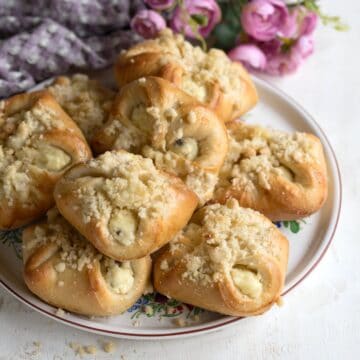
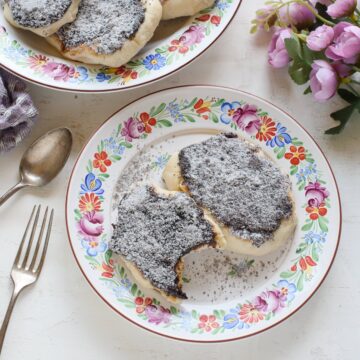
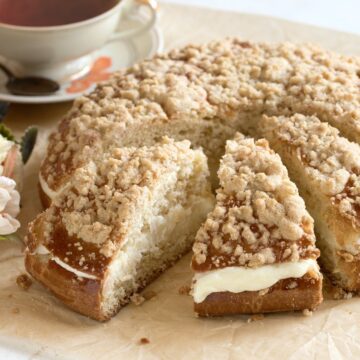
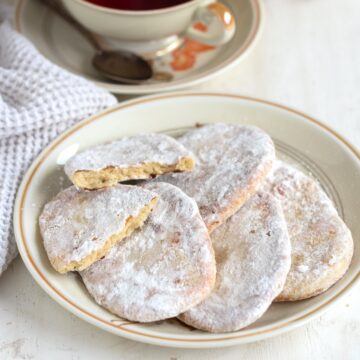
Becky Dresselhaus
Delightful web site. My daughter-in-law is from Czech. Her mother and father now live in Portland, Oregon where I live and I am often treated to delicious Czech food. I love how your recipes are very visual and clearly explained. I look forward to making kolache tomorrow.
Petra
Hello Becky, thank you for your kind comment. I hope kochache will turn out perfect. Many lovely old-fashioned Czech recipes are very popular, waiting to be discovered. I´m going to make "vdolky" next weekend, similar to kolache. Looking forward to sharing them on the blog, too. Many greetings from the Czech Republic, Petra
Melissa
Love the recipe, and helpful hints! I’ve been making my grandma’s bohemian recipe for years, but lost her cream cheese/cottage filling recipe. Do you have a recipe for yours?
Petra Kupská
Hi Melissa, thank you for your comment! I am happy to recommend this tvaroh/cottage filling I use to fill the kolache. The secret ingredients are cornstarch and egg yolk, that firm the filling during baking so it doesn't leak out.
Nick
tried to make these 2 times and it never worked out.
Anicka Cooklikeczechs.com
Hello Nick, thank you for your feedback - I am so sorry to hear that! What seems to be the problem? Perhaps we can work it out, if it is something specific...
JoAnn Welch
I’m of Czech heritage. When very young I used to help my Grandma make kolaches. I am now in my 80’s and just now going to try making them on my own. I would like recipes for prune and other fruit filling recipes. Thank you for your article. Best Wishes and God Bless!
Petra Kupská
Ahoj, thank you for your kind comment. It's true that our Grannies were the best at baking classic kolaches, but I believe that we, the children and grandchildren, can make them very well too! In the Czech Republic, classic kolache fillings include those made of tvaroh (cheese), poppy seeds, and plum jam (švestková povidla). Just today I read an article on making homemade povidla (jam from plums). This povidla jam used to be cooked slowly at low heat until the liquid evaporated and the jam thickened. I will look for the exact recipe and will post it here on the blog. Most other fruit fillings will be prepared similarly, but I'd let you know. Many greetings from Czechia, Petra
DH
This is the best kolache recipe I have used. I brought most of them to work since the weather here would make them go bad quickly, and I could not eat all those kolache in a day; they were all gone within twenty minutes of me putting them out. Several of the people who tried them had never heard of kolache before today.
Take it seriously when it says to let them cool on the pan, however. I was in a hurry to get them cooled and put away, so I transferred them to a cooling rack immediately, but with one of them the plum filling slid right off.
Jane G. Kiser
I have been searching for an authentic Czech kolache recipe. I've been remembering the wonderful kola he's our head cafeteria lady at Jourdanton Elementary school would make periodically. I was a teacher there. She was of Czech heritage and she spoiled us with kolaches and other special treats, but I especially remember the kolaches. Can't wait to make and try these!
JaneGKiser
Sorry for misspellings in my comment on the kolache recipe. This happens on my iPad and phone when I type a non-English word. Makes me furious!
Petra Kupská
Ahoj Jane, thank you for your comment, I appreciate it! Classic Czech kolache pastry is made with yeast dough, it can be tricky sometimes. A well-made dough depends on the quality of yeast, absorbency of the flour, whether the ingredients (especially the milk and butter) are just right when warm. Yeast dough requires respect. Often the right feeling of good yeast dough is only acquired after some time of practice. The dough must not be too thin, i.e. sticky, but not too stiff either. Then the koláče would not be as fluffy as expected.
I also find it challenging for me to convert European measurements to the US system 🙂 Measuring in cups and spoons is more inaccurate than grams and milliliters - there may occur some inaccuracies here. I work the dough with my hands because I "feel" it, I know if it needs a little more flour added or not.
My tip: let the dough rise for at least an hour in a warm place, covered with a kitchen towel or cling film, so that the surface doesn't dry out. When you've made the dough into pieces for shaping into cakes, let it rise again (see step No. 11 in the recipe card). Kolaches need time; Czech babi (grannies) used to start baking in the morning so that the koláče would be ready to eat in the evening.
I really hope you find these few tips helpful and I'd love it if you let me know how the kolaches turn out using this recipe! Best wishes, Petra
Aubrey
I am so excited to try this recipe! I lived in vsetin CZ for years and miss the traditional czech food.
I even found a store that sells kofula!
Diki moc for sharing this recipe!
Petra Kupská
Oh, Vsetín is a town in an area rich in cultural traditions! It must have been lovely to live here 🙂 Ha! And Kofola is one of the most popular drinks here in the Czech Republic, glad you found it in the US too! You're welcome (není zač); I enjoy sharing Czech recipes, I'm delighted you discovered my blog. Greetings from the Czech Republic, Petra
Roland Rojas
I found this recipe after having been disappointed by two different ones I found first. I have deleted all other recipes I found after making this one. This bread recipe is absolutely perfect. It is soft and savory complementing the preserves I used for the filling. I was so impressed I made a second batch and made sausage Kolaches using jalapeno cheese link sausage and they came out wonderful ! The recipe didnt say how much vanilla or lemon zest to use so I used one tsp vanilla and the zest of one large lemon and it came out great. Im anxious to try out more of your recipes, I am a new fan !
Petra Kupská
Ahoj Roland, thank you very much for your kind comment; and I'm so glad the kolaches turned out well! About the lemon zest and vanilla. You're right, I'll adjust the quantities, but you've got a good guess 🙂 I put them in the dough by eye, so I didn't realize that information was also relevant (my bad). Thanks for the heads up! With friendly greetings from the Czech Republic, Petra
Donna
Then you for the recipe. My grandmother and mother made these, and I appreciate the detailed recipe so I can do it. They topped their Kolaches with creme and sugar &cinnam on mixture. Have you done that?
Petra Kupská
Ahoj Donna, thank you for your comment and kind feedback. From your description, I judge your mother and grandmother may have made what we call "tvaroh cheese filling" in the Czech Republic. Tvaroh cheese is a type of fresh cheese that can be substituted for cream cheese in the US. Just add sugar, egg yolk, and vanilla. Stir to combine, and the filling is ready! About the sugar and cinnamon topping. In the Czech Republic, it is called "posypka" or "drobenka". It is made with flour, unsalted butter, and sugar. Sometimes a little cinnamon is added for extra flavor. Here is the recipe: Streusel topping I hope this helps. Greeting from Bohemia, Petra
Sandy Luksa
My grandma was from Moravia and immigrated to the U. S. into Texas later moving to Nebraska. Her maiden name was Machacekova. Your recipe is very similar to hers. The only difference I could see was she did not use lemon zest but added a pinch of mace instead. I never heard of plum butter. Can you tell me what that is and if there’s a recipe? I love plum dumplings so I’m sure a plum kolac would be wonderful. Love reading your blog.
Petra Kupská
Ahoj Sandy, thank you for your lovely comment! Czech grannies often add various spices when baking sweet pastries. Freshly grated lemon zest is a common spice nowadays. The mace was one of the spices used in the past, and I can easily imagine it in the dough used to bake kolaches. Other spices previously used in sweet baking in Bohemia and Moravia included cardamom, aniseed, and star anise. The spices not only flavored the pastries but also made them more digestible. Best wishes, Petra
Mary Taylor
That is so interesting about those spices making the bread more digestible. I have always wondered why traditionally bread was such a big part of meals, and now it is taboo and a health hazard.
Cathy
My husband’s family is Czech but what they call kolache is a rolled sweet bread (like a jelly roll). Fillings are usually prune, poppy seed, apricot or cinnamon sugar-walnut. What would you call that?
Petra Kupská
Hi Cathy, couldn't these be Czech buchty? Here is the recipe: Sweet buchty buns
Stephanie
Thank you for your wonderful recipes! They are beautifully told with great pictures! My grandparents came from Czechoslovakia and unfortunately, I didn’t get my grandmother’s wonderful recipes. Finding your recipes has been a God send, and I’m trying as many of them as I possibly can. Your kolache recipe, including the recipes for the filling and topping, sounds just like my grandmother’s. Your strudel recipe, too, among others! Many thanks! I’d love to purchase a cookbook by you!
Petra Kupská
Ahoj Stephanie, Thank you for your kind words, it made me happy! The kolache(s) are a Czech classic, I'm glad they remind you of the ones your babicka (granny) used to bake. I don't plan to publish Czech recipes as a cookbook yet, although in the future, who knows 🙂
Matthew
Ahoj Petra,
Thank you for emailing us to remind us of this wonderful recipe. My great-grandparents were from Moravia and I remember my grandmother always made these for the holidays and birthdays. She would use the Solo brand fruit fillings, which are still available in some places. Of these my favorite was apricot. Thank you again!
Teri Wilcox
My babicka, Aneshka Drahota Kodes was from Vranice. She came to America in 1920. My favorite are poppy seed and prune. She put a little anise extract in the prune. I really enjoy your writing and recipes!
Petra Kupská
Thank you, Teri, for your comment! Anise used to be a favorite spice of Bohemian grannies. I myself am now discovering these spices and learning to use them in the kitchen. They make a big difference in the taste of food! Aniseed is added to the poppy seed filling, like your babicka used to do, along with pounded cloves, star anise, or freshly grated lemon zest.
Carole
My.mom would make kolaches just like your pictures except they were small like cookies. About 1 1/2 - 1 3/4 inches. My favorites were apricot, cheese, and a sugar/walnut mixture. So.yummy!! She was from Strunkovic, Bohemia.
Petra Kupská
Yay, these are called kolacky (a miniature version of kolache 🙂 Their preparation is quite challenging, the smaller, the more work. On the other hand, there is a famous Czech proverb that says: "Bez práce nejsou koláče" - something like: "No pain, no gain." (Without work, there are no kolaches). The mix of sugar and walnuts is also one of my favorite fillings!
Petra Kupská
Ahoj Matthew, thank you for your lovely comment! As a part of the Czech Republic, Moravia has always been known for its refined gastronomy; I believe your grandmother baked the best kolaches! Czechs usually make kolache fillings from scratch, but I've heard a lot of praise for the Solo fillings you mention—apricots as a filling sound very appealing. My pick is prune jam combined with cream cheese (Czech tvaroh cheese).
Milena Bartik
Those look amazing, I use to make them all the time when the kids were little, they were gone in no time. In my house hold only strawberry or raspberry with cream cheese went. In those days there was no internet to see how to make them, but to look at your recipes with all the pictures it looks so easy. Love your website.
Petra Kupská
Thank you, Milena, for your nice words 🙂 It's like in my family, the baked kolace are gone before I can turn around. Cream cheese filling with strawberries and raspberries sounds promising!
Sandy
Cottage cheese, apricot and pineapple are my favorites, all with a streusel topping.
Petra Kupská
Thank you very much for your kolache filling ideas! Streusel topping on kolaches is always a great idea 🙂
denise dumas
Ahoj, Petra
Thank you so much for this wonderful recipe. I miss CZ so much - pre-Covid, I spent several weeks each year in Brno. The wonderful breads and pastries are such a part of that city for me, and you have given me the ability to recreate a special one. Diki!
Denise
Petra Kupská
Ahoj Denise, thank you for your comment and nice words! I firmly believe that the situation will calm down in the summer and you will visit Brno again. If you try the recipe for kolace, let me know how they turned out! Posílám pozdravy z Čech 🙂 Petra
Nancy
Made these today. Wonderful dough, but dad not need full amount of flour.
Was twondering if I could use jam or preserves instead of canned pie filling. Did make cream cheese filling today.
Thanks for your recipe
Petra Kupská
Ahoj Nancy, thank you very much for your lovely comment! Since I'm not based in the US, I don't have a detailed understanding of the types of preserves available in your stores. In the Czech Republic, we use a variety of preserves (homemade and bought). It is important that the filling does not leak during baking - some preserves are not suitable for cooking. Try different types when baking and see what the result is!
Jonathan Dohnalek
Hi Petra, only one question. What is the fat content (%) of the milk, or maybe it does not matter? Thanks.
Petra Kupská
Hi Jonathan, thank you for reaching out! In the Czech Republic, we usually use 1.5% fat cow milk, but feel free to grab whole milk (around 3.8% fat). Petra
Surati
I want to say something. Thank you for your detailed recipe. My Grandmother was born and raised near Prague in the countryside ( not sure what that area is called these days). Her name was Anna, and she made Kolache, like yours with about 4 different fillings; prune, apricot, poppyseed and cheese. OMG, they were so delicious. Even tho' I saw her make them many times, I failed to write down the recipe. Your's looks so good, I've read a lot of different ones on the internet, but none so carefully done as yours. I like that you are using only 1/3 cup sugar to the 3 1/2 cups flour, now I know they will be delicately sweetened. Thank You . I will use my standing mixer, just because I have one.
Petra Kupská
Perfect! I thank you for your nice comment and kind words. Fingers crossed that the Kolache turn out the way your grandmother Anna used to make them!
Surati
My Cech grandmother never used preserves, she used dried fruit, such as prune and apricot.
Petra Kupská
The most traditional fillings for traditional Czech cakes are poppy seed, cottage cheese and fudge. A variety of seasonal fruits were most often used to decorate the cottage cheese filling. If preserves are used today, they should be chosen that are suitable for baking (they do not leak out).
Rosalia Q. Figueroa
I tried this recipe, and it was perfect, but I have questions I want to ask; how can I reach you?
Petra Kupská
For sure, write me at petra@cooklikeczechs.com! And thank you 🙂
Sandy
A group of us (all Czech cousins) just made 300 kolache for my cousin’s 50th birthday. We had so much fun doing so and they turned out so yummy. We made cottage/cream cheese, poppyseed, prune, apricot, cherry, apple and pineapple. We used our babi’s recipe which is very similar to yours.
Petra Kupská
That's fantastic, I am really happy with how the kolache turned out! I think that in addition to the recipe, the preparation with your cousins played a significant role in the wonderful outcome. It is always better to work with pleasant people 🙂 I also want to say happy 50th birthday to your cousin!
Megan
My husband and I made these tonight and they were so great!! My great grandparents came from Czechoslovakia but they died before I knew them. I would like to think that my babi would have passed this recipe to me if she could have! Thank you for teaching it to me!
Petra Kupská
Thank you, Megan, for your nice comment! I am glad you liked the recipe and that it reminded you of your beloved babi's baking 🙂
Ray E. Cartier
We were about to try to duplicate your instructions when I discovered that I had no idea as to the amount of milk and flour that are needed.
If those are in there and I missed them, they should be highlighted.
Petra Kupská
Hi Ray, thank you for your helpful note. Only the values given in imperial units (i.e. cups, spoons, etc.) will be recalculated if you change the batch quantity in the recipe card. The numbers in brackets do not change; you must manually multiply or divide them if necessary. I'll make a note on the recipe card to explain how the ingredient quantity conversion works.
Laurel
Hello!
These are currently in the oven, but my dough seemed really dry. It didn't rise much and cracked along the edges when I shaped it. I've checked and rechecked the recipe and followed it exactly. I'd love to have these turn out as gorgeous as they look in your pictures (they still smell amazing!), any suggestions?
Petra Kupská
Hi Laurel, I'm sorry to hear you're having trouble with the recipe! It is possible that some types of flour may be drier and absorb more liquid than others. Did you knead the dough by hand, please? The dough needs thorough processing. It also helps to let the dough rise in a closed oven with a pot of hot water on the bottom. A warm, moist environment does wonders for the dough's rising! I hope the kolache turned out well in the end.
Dan
Ahoj Petra, kolaches in the oven in memory of my grandma who taught me how to bake. Used a mixed plum, red currant, and tart cherry jam made from fruit from our yard, with a splash of rum and slivovitz from CZ! Will share at Easter family gathering. Thank you for the helpful recipe!
Anicka Cooklikeczechs.com
Ahoj Dan, thank you for the nice comment. I am happy the recipe reminded you of your grandmother´s baking. I hope your family will like it as well!
Courtney Gibson
I am new to kolache recipes, I bake a lot of goodies for work potlucks and my friend asked me to make them. Said he cannot find any in our area. With that said I’ve never made pastry dough from scratch before and I’m just wondering if my test batch came out right.
They look the same and taste good, but they are not flaky like I am used to, more of a dense bread like texture. Is this correct? Since I have no reference I am unsure. I don’t know if I overworked the dough or underworked it… just want to make them perfectly 😍
Anicka Cooklikeczechs.com
Dear Courtney, thank you for your comment and I hope the Czech kolace are a success! The kolace are baked with yeast dough and the texture could indeed be described as bread-like. They are beautifully fluffy on the first day, and last similarly on the second and third day.
Let me know how the baking turns out! 🙂
Nina
My boyfriend sent me this recipe to make for "my kids" lol but I can't find any coarse sugar, can I replace it with something else and get the same result? I'm desperate, I really want to make this and have it turn out like he remembers it to be.
Mira
Hello Nina, if you have cubed sugar available, it can be crushed in a grinder or mashed with a rolling pin and used as coarse / granulated sugar. In need, you can also use powdered sugar, but it contains about 3% anti-caking agent, mostly starch, so expect it may be a bit less sweet.
Julinne
Can you freeze kolache? If so, what is the best method?
Jenny Robinson
Hi! I'm excited to make these for my friends baby shower, she is from Czech Republic and requested these. Am I able to make dough the day before (with fillings) and place in fridge after the first rise? Would like to not be rushed in the morning as I am also preparing Chelbicky.
Petra Kupská
Hi Jenny, thank you for your comment! Regarding the Kolache dough, you can prepare it in the evening and let it rise in the refrigerator overnight. You can also prepare the fillings in advance and store them in the fridge. However, be mindful that the fillings should be at room temperature when they come into contact with the raised dough, so don't forget to take them out of the fridge in time. Have a great baby shower!
Pane Kofroně
Czech Texan here. Prasek's Hillje Smokehouse in Texas used to have decent Kolache as well.
Thank you for the recipes! I will be trying it soon along with your tvaroh and poppy seed filling recipes.
https://www.praseks.com/department/b-jos-czech-bakery/
Petra Kupská
Thank you for your note!
Jamie Shumbera
I just love your website! Thank you for this wonderful recipe.
Petra Kupská
Thank you, Jamie, for your kind words!